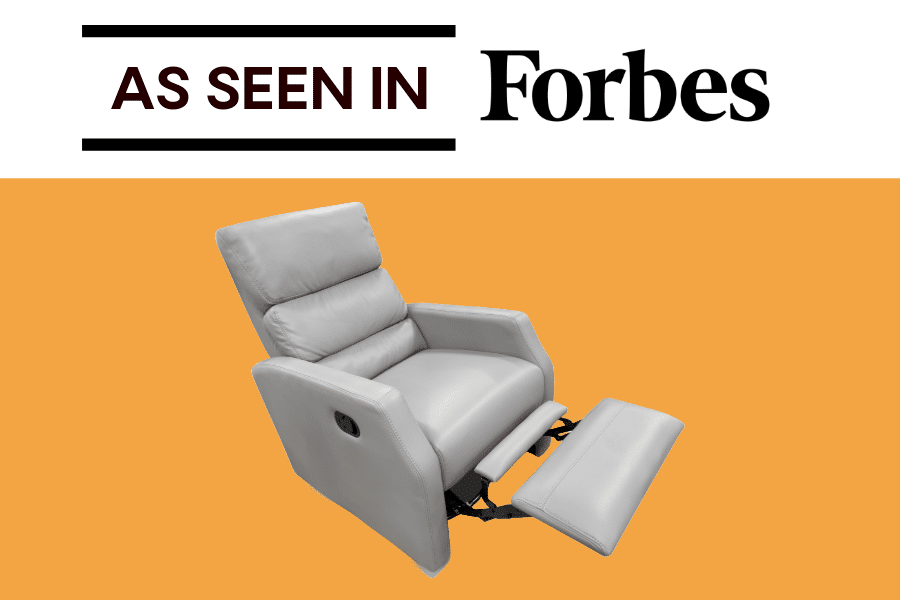
A Neurosurgeon’s Guide to Pain-Free Reclining
Whether you’re a couch potato or just wanting to relax after a long day, sitting in a recliner chair should be a pain-free experience for your back. Don’t let binging a new show or your afternoon nap get in the way of your spine health when it doesn’t have to. Although exercise is important for the condition of your back, lounging in a recliner can provide just as much relief as long as you follow these tips and guidelines, as laid out by Dr. William Kemp and featured in a Forbes article.
Depending on the specific spine condition, recliners can be a good option for people with back pain if used in moderation and as advised by a spine specialist. A well-designed recliner can provide excellent support and comfort, potentially reducing strain on the lumbar spine and alleviating lower back pain. Reclining can help relieve this pressure and eliminate the gap between your lower back and the chair. It can also relieve stress and tension in your body and improve blood circulation, which can further alleviate pain.
5 Features to Look for in a Recliner to Avoid Back Pain:
Not all recliners are created equal, so choose one that provides proper lumbar support and alignment. Additionally, it’s important to avoid being stationary, and I strongly advise against sleeping in a recliner. If your spine condition results in any numbness in your legs and feet, it is especially important to not stay in the same position for too long. Regular movement and activity are essential for maintaining spinal health and preventing stiffness and discomfort. However, there are plenty of things to look for in an ideal recliner chair to put your back at ease. These are some things to look for in a supportive recliner chair for all your relaxation needs.
- Lumbar Support: Lumbar support is essential in maintaining spinal health and alleviating pressure on your back. Ensure the recliner has built-in or adjustable lumbar support to maintain the spine’s natural curvature.
- Multiple Reclining Positions: When people complain that their recliner is hurting their back, it is often due to their chair being set to a bad angle. Selecting a recliner with several degrees of recline helps find a comfortable angle most suitable to your body.
- Adjustable Headrest and Footrest: Finding a recliner that has adjustable headrests and footrests is essential for a unique relaxation experience. These features help customize the seated position for each person’s unique anatomy. This also aids in maintaining a neutral spine position and additionally provides support for the neck and legs.
- Firm Padding: Although it can be difficult to forgo the softnest recliner, opt for a recliner with firm (yet comfortable) padding that conforms to the body’s contours without sagging, ensuring adequate support. It is also important that these recliners are in good condition and are not too worn.
- Bonus Feature! Heat and Massage Functions: Heated recliners and massage capabilities in recliners do wonders for your relaxation time. These added features can help relieve muscle tension and improve blood circulation, which can be beneficial for those with back pain.
Neurosurgeon-Approved Tips for Reducing Back Pain when Lounging:
During football season, I often spend too much time on the couch in the same position myself. Having a supportive recliner is just the first step in ensuring your back stays in good condition while relaxing or cheering on your favorite team. There are also plenty of other techniques to reduce your back pain even when you have a comfortable and supportive recliner. These five tips expand on the ways to ensure your back stays pain-free in your recliner.
- Use a Supportive Pillow: Place a small pillow or rolled towel behind the lower back to behind your lower back to maintain the natural curve of your spine. You can also use pillows to support your neck and legs.
- Maintain Good Posture: Recliners help distribute weight more evenly, reduce pressure on the lower back, and allow the muscles to relax. To improve your posture, you can try changing positions often and avoiding slouching.
- Take Breaks: Like with any chair, avoid sitting in the same position for too long. According to NIH, it is important to stand up, stretch, and move around every 30 minutes to prevent stiffness and improve circulation. Use commercial breaks as the opportunity to incorporate movement into your relaxation period. Maximizing mobility will greatly improve your spine condition.
- Incorporate Stretching and Strengthening Exercises: Regular exercises focusing on core strength and back muscles can help improve posture and reduce pain. Yoga is a very relaxing activity that also has many benefits for your mental and physical health. Light stretching before and after lounging can also be beneficial.
- Stay Hydrated and Maintain a Healthy Diet: Proper hydration and nutrition can support overall spinal health and reduce inflammation, contributing to pain relief. Even when you are lounging, drinking water and ingesting anti-inflammatory foods is extremely beneficial for your back to stay in good condition.
Even relaxation should have some guidelines to ensure your back and neck stay in good condition. Overall, some key takeaways you should be ultimately considering are these:
- Remember to place a priority on lumbar support, either through the design of the recliner or through a pillow to support your spine.
- Look for an adjustable recliner with somewhat firm padding.
- Stretching, taking breaks, and good posture will also ensure your spine stays in good condition during relaxation time.
These recliner guides and lounging tips should give a clear picture of how to avoid further straining your back while kicking back. Now, you can get back to cheering on your sports team and watching the new season of your favorite show without any lower back pain.
Topics covered
About the Author
Featured Resources
Insights to Achieve a Pain-Free Life



